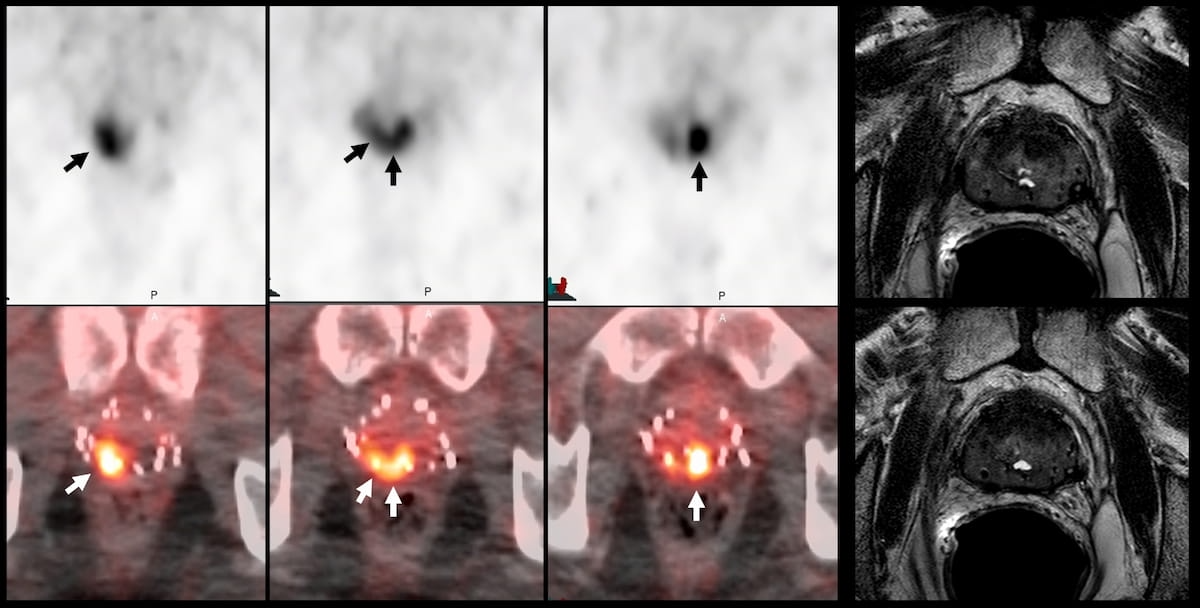- AI
- Molecular Imaging
- CT
- X-Ray
- Ultrasound
- MRI
- Facility Management
- Mammography
Can an Emerging PET Radiotracer Be a Viable Alternative to Multiparametric MRI for Detecting Prostate Cancer Recurrence?
In an analysis of patients with intraprostatic/prostate bed findings of biochemical prostate cancer recurrence, the use of 18F-DCFPyL PET/CT led to an 82.3 percent cancer detection rate in comparison to 80 percent for multiparametric MRI, according to research presented at the recent Society for Nuclear Medicine and Molecular Imaging (SNMMI) conference.
For patients with intraprostatic/prostate bed findings of biochemical prostate cancer recurrence, the use of 18F-DCFPyL PET/CT with positron emission tomography/computed tomography (PET/CT) offers comparable detection to multiparametric magnetic resonance imaging (mpMRI), according to researchers from the National Cancer Institute, who presented their findings at the recent Society for Nuclear Medicine and Molecular Imaging (SNMMI) conference.
For the prospective study, researchers reviewed data from 213 patients (mean age of 67) with biochemical recurrence of prostate cancer. All patients in the study cohort had mpMRI and PET/CT with 18F-DCFPyL (Pylarify, Progenics Pharmaceuticals/Lantheus). The study authors noted that 115 patients had positive intraprostatic/prostate bed findings. These patients included 58 post-prostatectomy patients and 57 patients who were previously treated with radiation, according to the study.
For the 53 prostate cancer lesions diagnosed in post-prostatectomy patients, 22 lesions were detected with MRI alone, six lesions were diagnosed with PSMA PET/CT alone and 25 lesions were detected with a combination of the two modalities. For this cohort, researchers noted cancer detection rates of 83.7 percent for mpMRI, 92.1 percent for PSMA PET/CT and 94.2 percent for the combination of the two modalities.
In the above images, the use of 18F-DCFPyL PET/CT reveals several abnormal foci while multiparametric MRI was negative in a 70-year-old patient who had biochemical recurrence nine years after previous treatment for prostate cancer. (Images courtesy of the Society for Nuclear Medicine and Molecular Imaging (SNMMI)).

For the 66 prostate cancer lesions detected in post-radiation patients, 17 lesions were diagnosed with MRI alone, six lesions were detected by PSMA PET/CT alone and 43 lesions were diagnosed with a combination of the two modalities. The study authors noted cancer detection rates of 83.7 percent for mpMRI, 92.1 percent for PSMA PET/CT and 94.2 percent for the modality combination in this cohort.
“18F-DCFPyL-PET/CT and mpMRI show similar cancer detection rates of intraprostatic/prostate bed recurrences, and the combination of 18F-DCFPyL-PET/CT and mpMRI provides superior diagnostic performance than either modality alone,” wrote study co-author Baris Turkbey, M.D., a senior clinician and radiologist affiliated with the Molecular Imaging Branch of the National Cancer Institute and National Institutes of Health (NIH) in Bethesda, Md., and colleagues.
While mpMRI demonstrated a higher detection rate than PSMA PET/CT for prostate cancer lesions, the study authors noted a lack of pathology confirmation for all lesions and a higher number of false positives with mpMRI.
Reference
1. Mena E, Lindenberg L, Lin F, et al. Comparison between 18F-DCFPyL-PET/CT and multiparametric MRI in assessing recurrence within the prostate in patients with biochemical recurrence of prostate cancer. Poster abstract presented at the 2023 Society for Nuclear Medicine and Molecular Imaging (SNMMI) Annual Meeting June 24-27, 2023 in Chicago. Available at https://am.snmmi.org/iMIS/SNMMI-AM . Accessed August 16, 2023.
Study of Ofatumumab for Multiple Sclerosis Shows 'Profoundly Suppressed MRI Lesion Activity'
April 17th 2024The use of continuous ofatumumab in patients within three years of a relapsing multiple sclerosis diagnosis led to substantial reductions in associated lesions on brain MRI scans, according to research recently presented at the American Academy of Neurology (AAN) conference.
Could a Deep Learning Model for Mammography Improve Prediction of DCIS and Invasive Breast Cancer?
April 15th 2024Artificial intelligence (AI) assessment of mammography images may significantly enhance the prediction of invasive breast cancer and ductal carcinoma in situ (DCIS) in women with breast cancer, according to new research presented at the Society for Breast Imaging (SBI) conference.
Interventional Radiology Study Shows Low Breast Cancer Recurrence 16 Months After Cryoablation
March 29th 2024In a cohort of patients with invasive breast cancer and tumor sizes ranging between 0.3 to 9 cm, image-guided cryoablation was associated with a 10 percent recurrence rate at 16 months, according to research recently presented at the Society of Interventional Radiology (SIR) conference.
Emerging Insights on MRI-Guided Transurethral Ultrasound Ablation for Prostate Cancer
March 21st 2024For men with prostate cancer, the use of MRI-guided transurethral ultrasound ablation (TULSA) led to a 92 percent decrease in median prostate volume at one year, according to new research recently presented at Society of Interventional Radiology (SIR) conference.
Could Cloud-Based 'Progressive Loading' be a Boon for Radiology Workflows?
March 13th 2024The newly launched Progressive Loading feature, available through RamSoft’s OmegaAI software, reportedly offers radiologist rapid uploading of images that is faster than on-site networks and other cloud-based systems regardless of the network radiologists are using.
ECR Study Finds Mixed Results with AI on Breast Ultrasound
March 6th 2024While adjunctive use of AI led to significantly higher specificity and accuracy rates in detecting cancer on breast ultrasound exams in comparison to unassisted reading by breast radiologists, researchers noted that 12 of 13 BI-RADS 3 lesions upgraded by AI were ultimately benign, according to research presented at the European Congress of Radiology.
